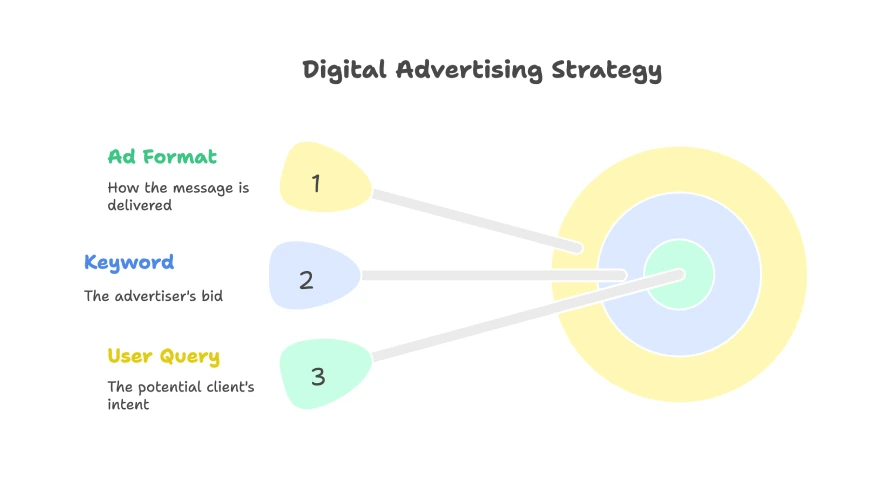When explaining Google Search ads to a new client or studying for the Google Ads Search Certification, start with the basics. Each search ad has a few key parts that link what users search for to what advertisers want to promote. Understanding these parts gives you a solid foundation for both the exam and real-world campaigns. Let’s go to the main question below.
Table of Contents
The Question
Which one of the following groupings would you highlight to them as the three basic components of a Google Search ad?
- Queries, marketing goals, and Search ads
- AI, bid strategies, and creatives
- Targeting, ad formats, and bid strategies
- Queries, ad formats, and keywords
The Correct Answer
Option 4: Queries, ad formats, and keywords ✅

Why the Correct Answer Is Right
1. Queries (User Intent)
Queries are the words typed into Google’s search bar by users. They reflect what someone is actively looking for. For example:
- “best dentist near me”
- “affordable running shoes”
- “coffee shops open late”
👉 Queries are not controlled by advertisers; they come directly from the user. But they are the starting point for every Search ad interaction.
2. Keywords (Advertiser’s Signal)
Keywords are the phrases advertisers bid on to signal to Google which searches they want their ads to appear for.
- They connect the user’s query with the advertiser’s ad.
- Advertisers can choose different match types:
- Exact Match [ ] → Triggers only when the search matches the keyword closely.
- Phrase Match ” “ → Matches searches containing the phrase in the same order.
- Broad Match → Matches searches with related meanings, even if the exact words aren’t used.
👉 Keywords are like the bridge between user intent (queries) and advertiser action (ads).
3. Ad Formats (The Message)
Ad formats define how the ad is structured and displayed. For Search ads, this typically includes:
- Headlines – The bold clickable text (up to 3 lines).
- Descriptions – Supporting text to explain benefits, offers, or calls-to-action.
- Display URL – The visible web address that appears under the headline.
- Ad Extensions – Optional add-ons like sitelinks, call buttons, location info, or images.
👉 Ad formats determine how appealing and useful the ad looks in search results. Even if a query matches a keyword, a poor ad format can reduce performance.
Why the Other Options Are Incorrect
| Option | Why It’s Wrong |
|---|---|
| Queries, marketing goals, and Search ads | Marketing goals guide campaign strategy but aren’t part of an ad’s structure. |
| AI, bid strategies, and creatives | These relate to optimization and automation, not the core building blocks of an ad. |
| Targeting, ad formats, and bid strategies | Targeting and bidding happen during campaign setup, not within the ad itself. |
Summary:
| Component | Role in Search Ads |
|---|---|
| ✅ Queries | What users type into Google |
| ✅ Keywords | What advertisers bid on to match queries |
| ✅ Ad Formats | How the ad is structured and shown |
Real-Life Example
Let’s say Alex owns a small fitness studio and wants to attract new clients searching for personal training.
- User Query (Intent): A potential client types “personal trainers near me” into Google.
- Keyword (Advertiser’s Bid): Alex has set the keyword phrase “personal trainer near me” in his campaign.
- Ad Format (Message Delivery): Google shows Alex’s ad:

Headline: Certified Personal Trainers Near You
Description: Get custom fitness plans. Free consultation today.
Extensions: Call button + Location link to the studio
Because all three components aligned, the ad appeared exactly when someone was looking for his service — increasing the chance of conversion.
Relevant Resource Links
- Google Ads Search Certification (Skillshop)
- How Search Ads Work – Google Ads Help
- Keyword Match Types – Google Ads Help
- Ad Formats in Search – Google Ads Help
Conclusion
The foundation of every Google Search ad rests on three core components:
- Queries – What people are searching for.
- Keywords – The advertiser’s chosen triggers for when their ad should appear.
- Ad Formats – The structure and style of the ad displayed in search results.
By mastering these basics, you’ll not only ace the Google Ads Search Certification Exam but also gain the confidence to explain Search ads to clients in a clear, simplified way.
👉 Remember: No queries = no ad triggers. No keywords = no targeting. No ad formats = no visible message. All three must work together for success.
Now, if you are ready, then you take the Google Skillshop test for the Google Ads Search Exam. If you want more questions about the Google Ads Search Certification Exam, follow.
FAQs
What is the difference between a query and a keyword?
A query is what the user types into Google.
A keyword is what the advertiser chooses to bid on.
👉 Example: Query = “buy running shoes,” Keyword = “running shoes.”
Can ad formats include images?
Traditional text search ads are text-based, but Google now offers image extensions and other add-ons that enrich the format.
Are bid strategies part of an ad?
No. Bid strategies determine how much you pay per click or conversion, but they don’t form part of the ad’s visible structure.
Do queries always match keywords exactly?
Not always. Broad match keywords, for example, can trigger ads for related searches even if the words differ slightly.
